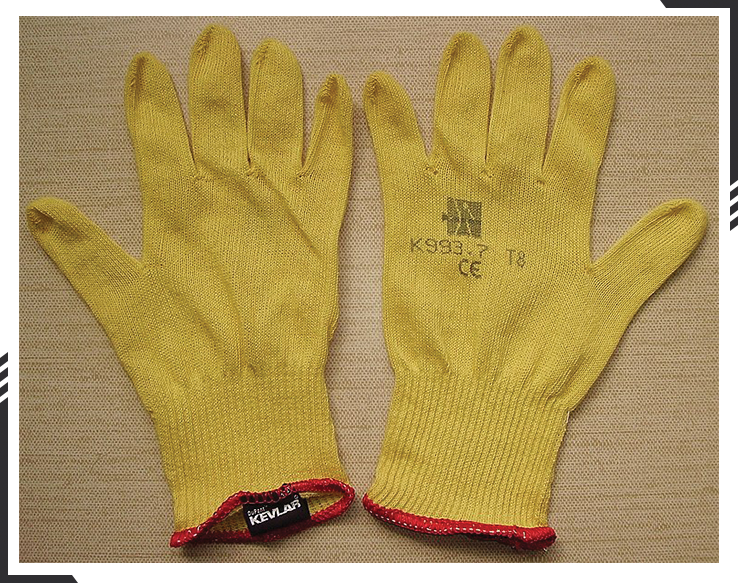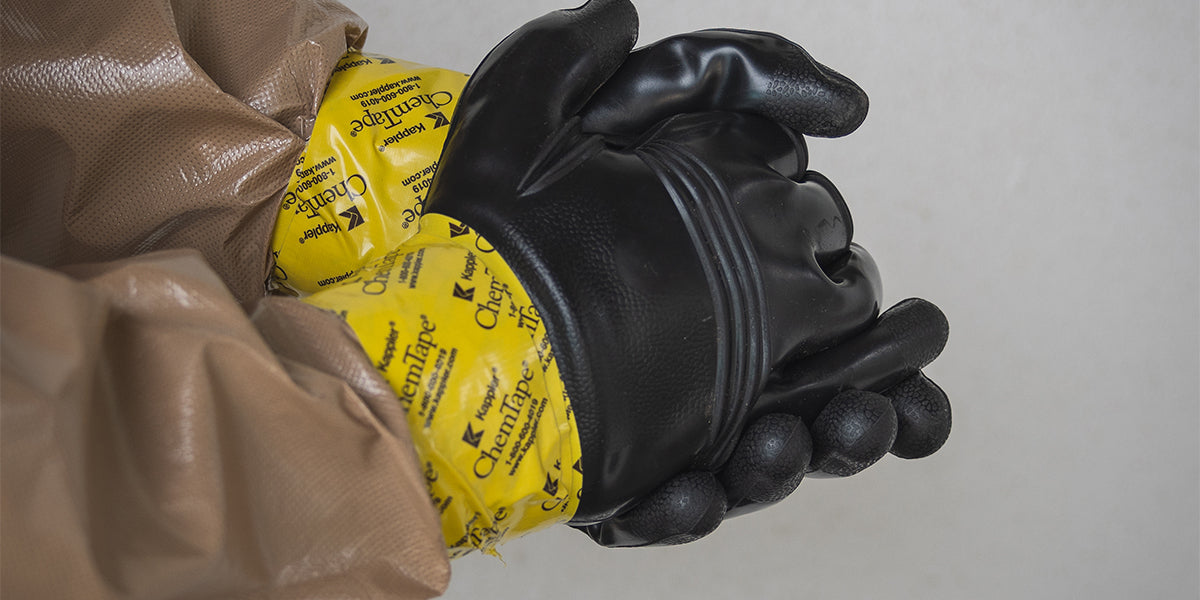Your hands are the primary means by which you interact with your environment. They grab doorknobs daily, pick up trash, and hold the steering wheel. Because your hands touch and do so many things, protecting them in dangerous environments is vital.
Whether working with knives, stringing a barbed-wire fence, or navigating through the area of a chemical release, we need to be able to protect our hands. Otherwise, severe lacerations, infections, loss of movement, or even dangerous absorption of chemicals can result.

Perhaps the chief way to protect our hands—and, therefore, our overall health—is by wearing gloves. But not just any gloves will do. Much like a toolbox contains different tools for different tasks, and there are other gas mask filters for different environments, there are also a variety of gloves for various purposes.
Choosing the wrong glove for the job can create an even more dangerous situation. You could be completely unprotected, but the false sense of security the wrong gloves give you could lead to engaging in overly risky behaviors.
Of course, you must know the suitable gloves for the task. Many people need to become more familiar with the different types of gloves and need clarification about what each type is for.
To cut through the confusion, we at MIRA Safety have created this easy-to-read guide to help. You need to know this guide before choosing suitable gloves for the job.
TABLE OF CONTENTS
-
01
How does OSHA categorize gloves?
-
02
Leather, Canvas, or Metal Mesh Gloves
-
03
Fabric and Coated Fabric Gloves
-
04
Chemical and Liquid-Resistant Gloves
-
05
Insulating Rubber Gloves
-
06
How do I know which glove to choose for the job?
-
07
How do I know what level of cut protection I need?
-
08
What are the best gloves for NBC threats?
-
09
Proper gloves are essential to disaster safety
How does OSHA categorize gloves?
The Occupational Safety and Health Administration (OSHA) classifies gloves under various categories in the US. For our purposes, we're sticking with their classification system as it's a good representation of the number and types of gloves available for work purposes.
OSHA glove categories:
-

Leather, canvas, or metal mesh gloves
-

Fabric and coated fabric gloves
-

Chemical and liquid-resistant gloves
-

Insulating rubber gloves
Let’s look at each in turn.
Leather, Canvas, or Metal Mesh Gloves
This gloves category is helpful for general work as a protection against abrasions, cuts, and scratches. They're not meant to be used for chemical contact work, as they don't offer significant protection against such substances.
Leather Gloves
These are typical work gloves that can be found in any garden shed or barn. While they offer decent protection against abrasions, they don't provide cut resistance. When using a blade of any kind, these won't provide an adequate level of safety.

However, they offer low-level protection against heat, and they can protect the hands when handling rough objects (e.g., masonry) and against sparks and other minor threats. They offer no protection against chemicals and will absorb liquids. For tasks that require a great degree of dexterity, these are a terrible choice. Fortunately, they are tear-resistant, meaning they have a long lifespan as gloves go.
Canvas Gloves
These also protect against low-level heat and abrasions, but that's genuinely about it. These are commonly used in gardening.

Metal Mesh Gloves
While these gloves offer superior cut and puncture protection, they do not provide heat protection. Because metal conducts heat, attempting to pick up a very hot object with these gloves is likely to result in a burn.
Fabric and Coated Fabric Gloves
Typically, both of these types of gloves are made of cotton, and they are not designed for heavy-duty use.
Fabric Gloves
These simple, general-purpose gloves offer minor protection against abrasions, but that's about it. They are not suitable for any chemical work whatsoever. They are typically used for aesthetic purposes or to protect items from the dirt and oils on the wearers' hands.

Coated Fabric Gloves
The coated fabric is simply a cotton glove on which the palm and finger areas have been treated with a rubberized coating. This provides a better grip when dealing with slippery objects and some protection against chemical agents (provided they don't come in contact with the cotton back of the glove).

Chemical and Liquid-Resistant Gloves
Chemical and Liquid-Resistant Gloves are the gloves category we're predominantly interested in here at MIRA Safety. We want to ensure that our customers are protected from biological and chemical threats, requiring chemical and liquid-resistant gloves. Anything less won't keep you as safe from these agents as you should be. As other articles pointed out, nerve agents can quickly soak through clothing and flow through gloves made of the same materials as clothing.
The same applies to bacteria and viruses, which are only a few microns in size. Wearing gloves with "holes" in the stitching that are larger than a few microns means there is no natural barrier between the skin and the infectious agent. It's akin to trying to stop mosquitoes with a chain-link fence.
Proper protection in either regard requires chemical and liquid-resistant gloves. As this is the type of glove MIRA Safety is interested in, we're examining them in great detail.
So, what are the options? Let's take a look.
Disposable Nitrile Gloves
These are a good choice for general laboratory use or those working in a healthcare setting, where incidental chemical contact is likely. They offer good protection against bodily fluids and tissues and admirable protection against grease, organic solvents, chlorinated solvents, oils, and some acids and bases.

In addition, they can be used by those with a latex allergy (they're hypoallergenic), and they provide a good level of manual dexterity. When working with syringes, flasks, or other objects that require fine motor control, manual dexterity is a necessity.
One of the great things about nitrile gloves is that when exposed to chemicals, they have a longer lifespan than many other forms of disposable gloves. They won't deteriorate as quickly as some, and it's undeniable when they rip or tear. This allows the user to promptly address the problem and avoid a dangerous predicament.
All of these factors make nitrile gloves an excellent choice for various situations.
When to avoid disposable nitrile gloves
Nitrile gloves don't offer sufficient protection against chemicals. In particular, when working with acetates, aromatic solvents, halogenated solvents, ketones, or potent oxidizing agents... this type of glove should be avoided.
Disposable Neoprene Gloves
Neoprene is a fake rubber and is another good general-use glove. Much like nitrile gloves, neoprene gloves provide a superior level of manual dexterity, and rips or tears are very obvious.
These are a good choice for incidental chemical contact, and they function admirably when working around acids, bases, and peroxides.

Many mechanics like using these gloves because they protect against these types of chemicals (often found in automobiles). In addition, neoprene gloves typically have a longer lifespan against chemical agents than natural rubber, meaning they're cost-effective protection that won't break the bank.
When to avoid disposable neoprene gloves
When working directly with chemicals (e.g., immersing the hands/holding a wet sponge) or working around halogenated solvents, a different type of gloves should be used.
Disposable Latex Gloves
These gloves used to be prevalent in healthcare settings because of the protection and manual dexterity they provide. However, the prevalence of latex allergies has resulted in these becoming less common in medical settings.

While latex gloves provide incidental protection against bodily fluids, some acids, and some bases, detecting rips is difficult. This can result in accidental exposure to bloodborne pathogens or noxious chemical compounds. Benefits of latex gloves include abrasion resistance, elasticity, comfort, and protection against acids, alkalis, salts, and ketones.
When to avoid disposable latex gloves
Those allergic to latex or who might come in contact with someone who is (e.g., a surgeon operating on a patient with a latex allergy) and those working around organic solvents should avoid latex gloves.
Butyl Rubber Gloves
For direct chemical contact, these synthetic rubber gloves are superb. They can be decontaminated and reused, resistant to punctures and rips, and protect against vapors, alcohols, aldehydes, gases, acids, bases, esters, nitro compounds, and ketones. They also offer a good deal of abrasion resistance and are resistant to oxidation.

Another benefit of these gloves is that they remain flexible in the cold. Many gloves stiffen when exposed to cold weather, hindering manual dexterity. In cold temperatures, this can make operating a weapon, programming a handheld radio, or picking a lock much more complicated than it would be otherwise.
When to avoid butyl rubber gloves
A different type of glove should be used if you need a great deal of manual dexterity or will be working directly with gasoline or aliphatic/aromatic/halogenated hydrocarbons.
The problem with butyl rubber gloves is that they keep liquid out and keep liquid in. This can cause them to retain moisture, making the hands sweaty and uncomfortable during prolonged wear. The key to beating this is wearing an inner glove liner. This is where MIRA Safety has your back.
Our HAZ-GLOVES come with inner cotton gloves that absorb moisture, helping your hands stay dry and comfortable as you protect yourself against dangerous threats.

Viton Gloves
Often, when butyl rubber gloves can't be used, Viton gloves are used instead. Like butyl rubber, they are rip and puncture resistant but offer better dexterity and protection against aromatic/chlorinated hydrocarbons. They're also a good choice for direct chemical contact.
When to avoid Viton gloves
When working with ketones, choose a different type of glove as these will degrade rapidly.
Polyvinyl Chloride Gloves
These are akin to Viton gloves because they offer decent manual dexterity, are suitable for direct chemical contact, and have similar puncture/rip resistance. However, they look profoundly different. These are often the glove of choice for working around acids, amines, bases, fats, oils, and peroxides.

When to avoid polyvinyl chloride gloves
When working with organic solvents, polyvinyl chloride gloves will not offer adequate protection.
Insulating Rubber Gloves
These gloves have many of the same properties as butyl rubber gloves and can also deal with extreme temperatures. Since these are often used in electrical work, they are tested by being soaked for 16 hours and then exposed to voltage. The degree to which they insulate against the electricity determines the grade they receive.
How do I choose the proper glove size?
Everybody's hands are different, and with gloves, it's hard to find a one-size-fits-all solution. For superior protection, gloves must be a good fit for the individual's hand.
If the gloves are too small, dexterity is limited, the risk of tears is greater, and the protection is inadequate. When gloves are too large, any chance at average manual dexterity is minimal, the possibility of accidents is greater, and a loose cuff can allow biological agents, chemicals, or other undesirable substances (e.g., sharp straw while bailing hay) to find their way into the glove.
A perfectly sized glove is a necessity. How are gloves sized, though?
The process is simple, and the only tool needed is a simple cloth tape measure. Wrap the tape measure around the palm to measure the circumference of the hand.
-

<7" is Extra Small
-

7.5" is Small
-

8" is Medium
-

9" is Large
-

10" is Extra Large
-

>10.5" is Extra Extra Large
Once you have that information, you'll be able to choose a glove that fits appropriately.
How do I know which glove to choose for the job?
There are several questions one should consider before choosing a glove. As noted above, the wrong glove for the job can easily (and quickly) lead to injury, so choosing the right glove is critical.
Here's what to consider.
What job am I about to do?
Will you be handling blades? What about slippery objects, dangerous chemicals, or items that put you at risk of abrasions? Will you be working with dangerously hot or cold objects?
Knowing what you'll be working with is the first thing to consider before picking gloves.

What are the health consequences if you come into contact with what you’re working with?
Whether you're a surgeon working with bodily fluids or a chemist developing new pesticides, you need to know what you're dealing with. Not understanding the threat is risky because the protection you choose may need to be improved.
Had Madame Curie understood the dangers of radiation, she would not have carried radioactive minerals around in her pocket. She didn't understand the health consequences, though. You want to avoid making the same mistake, and understanding the health consequences of inadequate protection is vital to prevent such an outcome.
How long will you be in contact with dangerous chemicals?
Some gloves protect against dangerous chemicals for a longer duration than others. If you are working in a lab setting where you anticipate having your hands immersed in chemicals for long periods, you need to know that your gloves can handle the threat.

To be as safe as possible, you need to know how long the gloves can be in contact with dangerous chemicals and still protect you. A chemical will eventually penetrate all gloves if the contact is long enough.
How much protection do you need?
Do you need gloves that extend up the forearm, or is a simple glove that terminates at the wrist adequate for the task? Consider this to determine the appropriate glove length.
For cleaning gym equipment with Lysol all day, gloves that terminate at the wrist are likely sufficient. A longer glove is desirable if assisting with the difficult birth of a breech baby calf.

How much manual dexterity do you need?
Manual dexterity is less critical for gross-motor tasks, such as stringing razor wire. In such situations, grace can be sacrificed for bulkier gloves that provide better protection against cuts, punctures, and abrasions.
However, hand protection is still necessary for filling test tubes via pipette, but a much greater level of manual dexterity is required. Attempting such a delicate task with bulky leather gloves would only result in potentially dangerous accidents.
Knowing the required level of manual dexterity is a must.
Are your gloves reusable?
Some gloves are reusable, so you need to know how to decontaminate them if necessary. For example, if you're maneuvering through a war zone where chemical attacks occur regularly, you need to know how to decontaminate your gloves.
Do you have a latex allergy?
Many individuals are allergic to latex. While latex is a fantastic material for gloves, if it causes significant skin irritation, that's a problem. Knowing whether such an allergy is present will help you choose the best glove for the job.

How do I know what level of cut protection I need?
If you'll be dealing with sharp surfaces and need gloves to protect against accidental cuts and punctures, be aware that gloves have graded levels of protection.
There are various standards for measuring the cut resistance of gloves (EN388/2003, ISO 13997, etc.), but we will focus on ANSI/ISEA 105. This metric assigns a number grade to gloves to indicate what types of activities they're suitable for.

Gloves rated 1 or 2 are for low cut-risk activities, while those placed at level 5 are the most cut-resistant gloves available. Knowing the cut resistance rating is crucial when choosing gloves for a task involving sharp objects or blades.
Many workers exposed to a high risk of cuts wear a lighter Kevlar glove underneath their standard-issue work gloves. This not only protects them from scrapes but improves their grip.

What are the best gloves for NBC threats?
Butyl rubber gloves are the best choice for NBC threats. As mentioned above, these gloves provide superior protection against a wide range of chemical agents, remain functional in cold weather, are reusable, and are also very strong.
These are all the traits that civilians need in the event of an NBC attack, as civilians will be on their own for an indeterminate time in the immediate aftermath of such an event. They won't know when things might return to "normal," nor are they likely to see whether they're moving through a contaminated area (e.g., a VX release).
Our NC-11 Butyl Gloves are specifically designed to protect against chemical agents, biological threats, and nuclear hazardous materials. It can be worn for upwards of 30 days without losing its protective properties while featuring extra cuffs to fit hazmat suits and uses a non-irritant construction. With a 15-year shelf life, this will more than last you for the next disaster.
For these reasons, butyl gloves provide the best protection against NBC threats. They're as tough as nails, last a very long time, and can be decontaminated—that's something virtually no other gloves can say.
Proper gloves are essential to disaster safety
The proper gloves are necessary whether you're looking for heavy-duty work gloves to prevent scrapes (and subsequent infections), avoid exposure to infectious bloodborne agents, or maneuver through a chemical weapons attack.
Working through any of these environments without proper gloves invites potentially catastrophic consequences. Half the battle is knowing which gloves to pick, and choosing the wrong gear for the job can be just as dangerous as choosing nothing. Imagine a hostage rescue team armed solely with shotguns, for example.
The same principle applies to gloves.
What are you preparing for? What risks do the tasks involve? Knowing the answers to these questions and the others outlined above will allow you to make the right choice to protect yourself and your family.
